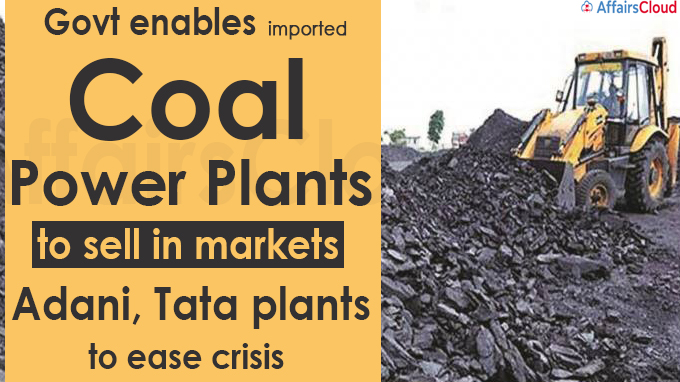 Even though being the world’s 2nd largest producer and consumer of coal (after China), India is currently facing a coal crisis.
Even though being the world’s 2nd largest producer and consumer of coal (after China), India is currently facing a coal crisis.
- As per the data of the Ministry of Power, coal stocks of the 135 thermal power plants of India reduced to an average of 4 days worth of stock.
- India consumed 124 billion units of power in August 2021 compared to 106 billion units of power in August 2019 (Prior to COVID-19).
- Reasons for the shortage of Coal stock: Heavy rains in coal mine areas in September 2021; Increase in prices of imported coal (~$150 a tonne); and Increase in electricity demand.
- Impact: The coal shortage would lead to downscale production in certain companies and in turn might delay the economic recovery (after COVID-19).
Way ahead: To overcome the coal crisis, the government has undertaken the following initiatives to improve the coal stock.
-Govt Enabled Imported Coal Power Plants to Sell Un-Requisitioned Power
Union Minister of Power and Ministry of New & Renewable Energy R K Singh approved certain guidelines over the provisions of National Tariff Policy, 2016 and enabled imported coal-based plants (having sufficient coal) to operate and sell the un-requisitioned power in the power exchange.
- The provisions will apply both for the power plants whose tariff has been determined under Section-62 and those having PPA (power purchase agreement) under Section-63 of the Electricity Act, 2003.
Key Points:
i.Objective: For optimum utilisation of un-requisitioned power and ease power supply shortages during high-demand periods in India.
ii.Due to the price of coal in the international market becoming ~ $150 a tonne, most of the imported coal-based power plants are not operating despite the high power scenario in the country.
iii.If the procurer does not requisition (demand) power from the power plant with which he has signed the PPA, (24 hours in advance prior to midnight of the day of delivery of power) the generator could sell the un-requisitioned power in the power exchange.
iv.The gains from the sale of such un-requisitioned power (after deducing energy charges) will be shared 50:50 between the developer and the procurers who are having the PPA.
v.Now with this provision, Adani Power and Tata Power could begin generation in their imported coal-based projects in Gujarat.
vi.Karnataka, Andhra Pradesh, Gujarat and Tamil Nadu have power plants that use imported coal with a total capacity of about 15 GW.
Note – The domestic coal-based power generation has grown by nearly 24 percent in 2021 (till September 2021)
-Coal Ministry Amended Mineral Concession Rules to Allow 50% Sale of Coal from Captive Mines
The Ministry of Coal has amended the Mineral Concession Rules, 1960 to allow the lessee of a captive mine to sell up to 50 percent of the total coal or lignite (on payment of additional amount) produced in a financial year.
Key Points:
i.The lessee could sell the coal or lignite only after meeting the requirement of the end-use plant that is linked with the mine and this condition is applicable for both the private and public sector captive mines.
ii.Background: In March 2021, the government amended the the Mines and Minerals (Development and Regulation) (MMDR) Act, 1957 named ‘MMDR Amendment Act, 2021’ to this effect.
- Through the amendment, the Centre has removed the distinction between captive (self-use) mines and merchant (commercial sale) mines.
- The MMDR Act regulates the mining sector in India and mandates the requirement for granting leases for mining operations.
iii.Benefit:
- The amendment would lead to the production and release of additional coal and will ease the pressure on power plants.
- The additional amount payment will improve the revenue of the coal and lignite bearing State Governments. It will also benefit over 100 captive coal and lignite blocks with over 500 million tons per annum Peak Rated Capacity.
iii.The Government has made provisions for grant of mining lease to a Government company or corporation for coal or lignite for 50 years to boost production of coal or lignite. The 50 years period could also be extended by 20 years upon requirement.
Note – Prior to 2015, the grant of mineral resources was through the ‘first come first serve’ method (now granting leases for mining operations).
Additional Information – The daily consumption of electricity has crossed beyond 4 Billion units per day. As per the annual report (2020-21) of CIL (Coal India Limited), 69 percent of the total electricity generation of India is coal-based.
- CIL alone produces around 83 percent of the country’s entire coal output.
Recent Related News:
The Ministry of Coal(MoC) constituted a Task Force under the Chairmanship of Vinod Kumar Tiwari, Additional Secretary of the Ministry of Coal and the Expert Committee under the Chairmanship of R.K Malhotra, Director General of the Federation of Indian Petroleum Industry.
About Ministry of coal:
Union Minister – Pralhad Venkatesh Joshi (Constituency – Dharwad, Karnataka)
Minister of State – Raosaheb Dadarao Danve (Constituency – Jalna, Maharashtra)
About Ministry of Power:
Union Minister – Raj Kumar Singh (Constituency – Arrah, Bihar)
Minister of State – Krishan Pal Gurjar (Constituency – Faridabad, Haryana)




